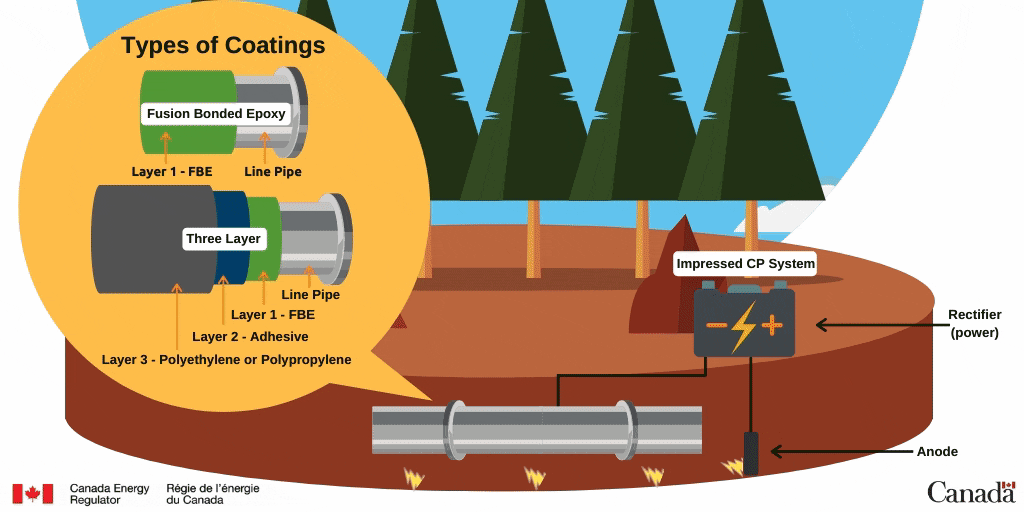Pipeline Coatings
The Canada Energy Regulator (CER) works for Canadians to keep energy moving safely and efficiently through our country’s pipelines and powerlines. In Canada, major pipeline systems are made of steel and, like any steel structure, can corrode when they come in contact with things like oxygen, water or moist soil. Corrosion can deteriorate or “rust” metal which then impacts its strength and appearance.
The good news is, however, that as part of proper design, maintenance and monitoring, the use of protective coatings can allow pipelines to be safely operated for many decades.
Protective coatings prevent corrosion by acting as a barrier, preventing the pipe’s metal from directly contacting its surrounding environment. Coatings can also serve other purposes such as protecting against wear, weather proofing or resistance, and thermal or electrical insulation. Internal coatings can also be applied to protect against certain types of abrasive products the pipeline is transporting or to enhance flow.
When choosing the right coating, a number of factors are considered. For example:
- Above Ground Pipeline Coatings:ease of application, bonding properties, ability to block moisture, and UV resistance.
- Below Ground Pipeline Coatings:ease of application, bonding properties, and appropriate level of barrier strength against corrosive elements such as soil and water.
- Transition Areas:when a pipeline transitions from above to below ground, the above ground coating may have to be extended a short distance underground to allow it to guard against atmospheric corrosion, or additional coating applied. This means that the above or below ground coating properties being used must work well together to provide adequate protection.
Companies must account for these factors when dealing with new construction or carrying out repairs on existing pipelines.
Most Common Types of Coatings
In Canada, the majority of federally regulated pipelines are below ground. The most commonly used coatings today for below ground pipelines are Fusion Bonded Epoxy (FBE), two layer polyethylene or three layer polyethylene or polypropylene.
- FBE: provides barrier to corrosion. It is typically suited for soil and underwater temperatures between -40ᴼC to 80ᴼC, and provides protection against essentially all corrosion-related hazards
- Two layer or three layer polyethylene or polypropylene: provides adhesion, corrosion resistance, chemical resistance, temperature resistance, and mechanical stress resistance, and can be used where enhanced mechanical resistance or high temperature resistance is required
Coatings are the first line of defense against corrosion. As an additional measure, cathodic protection (CP) is also applied to the pipeline to act as a backup in the event that the coating is damaged or degrades. This technique uses “anodes” (positively charged electrodes) which are buried nearby and are connected to the pipeline. These anodes provide a protective negative electric charge to the pipe steel making the pipeline cathodic and protecting it in the event it comes in contact with any corrosive elements, such as water or soil. An anode may consist of a more easily corroding material that wears away first or is “sacrificed” while protecting the pipeline, or is part of an electric circuit with a rectifier (or power source) that provides impressed protective current to the pipeline. See infographic for visual representation.
What is the CER’s Role in Regulating Coatings?
Companies under our jurisdiction have to follow the Onshore Pipeline Regulations (OPR). Within the OPR there is a requirement that companies must have in place a corrosion control program as part their overall Integrity Management Program (OPR section 6.5). They must also follow the Canadian Standards Association (or CSA) Z662 which set out the standards for pipelines in Canada, including protective coatings.
The CER conducts a variety of compliance verification activities to test and ensure compliance with regulatory requirements and standards, including on pipeline coatings and other corrosion prevention measures. Preventing harm is the foundation of how the CER keeps people safe and protects the environment. If a company is not meeting regulatory requirements (coatings or other), the CER has a number of tools to obtain compliance, prevent harm and deter future non-compliance.

Description
Types of Coatings
- Fusion Bonded Epoxy (FBE)
- Layer 1 – FBE over Line Pipe
- Three Layer
- Line Pipe
- Layer 1 – Fusion Bonded Epoxy
- Layer 2 – Adhesive
- Layer 3 – Polyethylene or Polypropylene
Related Links:
Transcript:
At the Canada Energy Regulator, we hold companies to some of the strictest safety and environmental standards in the world.
Companies must follow the all the rules in the CER Act and its regulations.
Before a pipeline is allowed to operate, companies need to show us they have detailed plans for things like:
- Safety
- Protecting the environment
- Responding to emergencies and
- How they will keep the pipeline safe for life.
We review these plans regularly and make sure they are doing what they should.
On top of all this, we do targeted audits and more than 150 inspections every year.
This is in addition to 100+ technical meetings and training exercises.
We call these, compliance verification activities.
These activities can happen in the field, in corporate offices or any place where companies are doing work, at any stage of a project.
Audits and inspections help us spot potential issues, and take action before they become problems.
If we find any, we do what it takes to get companies back on track and to keep them from repeating the same mistakes in the future.
We have powerful tools to make sure companies correct what is wrong.
We can issue a written notice or a financial penalty. We can also restrict how a pipeline is allowed to operate or even totally shut it down if necessary.
Want to learn more about enforcement and how the CER works for you? Visit us online or contact us directly.
- Date modified:
